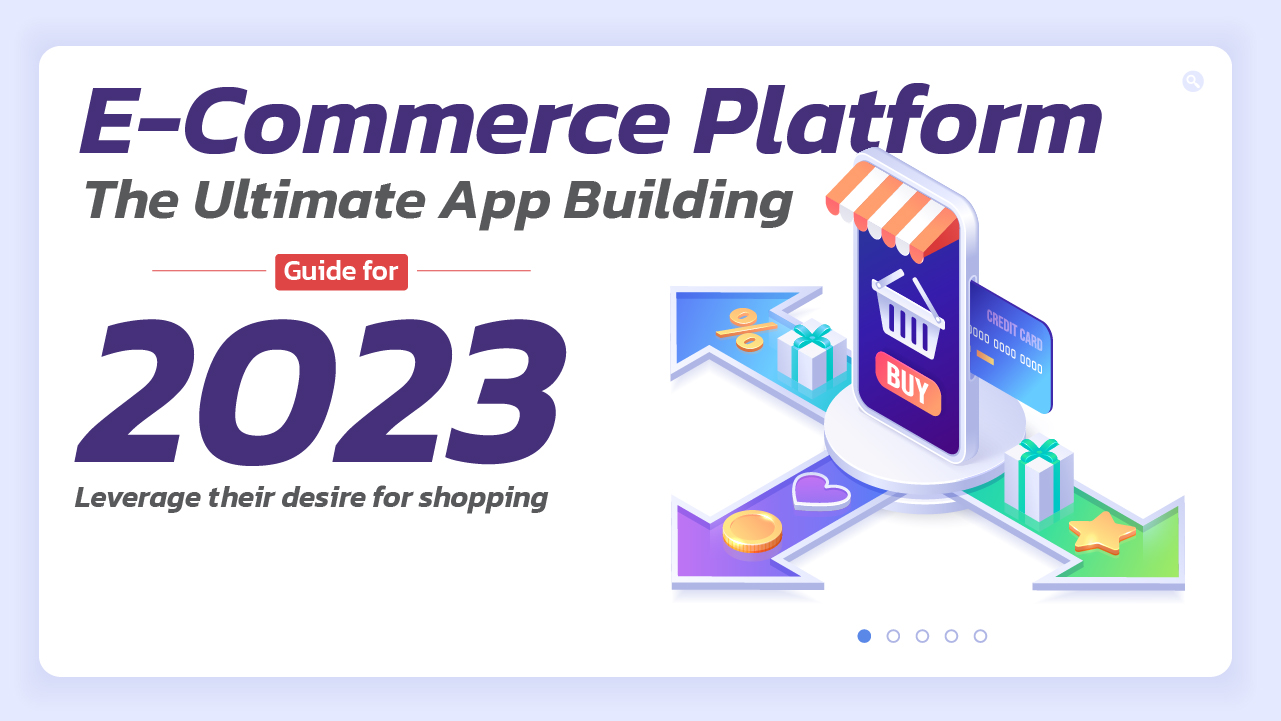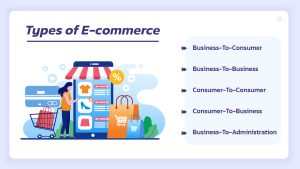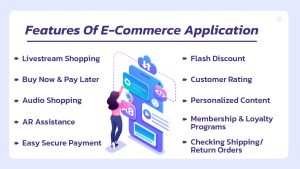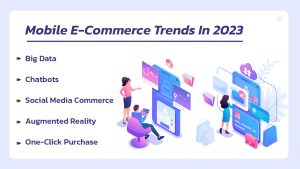E-com: The Ultimate App Building Guide for 2023

Although the term “e-commerce” technically refers to the use of an electronic medium for commercial transactions, it is frequently used to describe the sale of goods and services to customers or other businesses online.
The question of why to launch an e-commerce app is no longer relevant; rather, the issue is how to do it properly. An online store must provide the finest possible customer experience if it is to effectively attract and keep customers. Connecting with customers on all available contact points and consistently delivering a fantastic experience is vital to do this. The most crucial USP is having a smooth mobile experience. This is backed by the reason that mobile sales are swiftly catching up to mobile traffic, which currently makes up over 60% of all traffic. Additionally, 80% of customers visit a store’s mobile website while they are there.
Types of E-commerce

- Business-To-Consumer: It embodies the vast majority of the modern mobile applications that we use. It links a company providing a good or service to a specific client. Here, there is direct customer contact.
- Business-To-Business: A business-to-business e-commerce application deals with the exchange of goods and services between companies. As a result, the goods they sell are designed to be used as raw materials by other industries.
- Consumer-To-Consumer: In these apps, the exchange happens between two or more consumers. The best example of such dealings is the apps that facilitate the auctioning of products.
- Consumer-To-Business: Through such C2B e-commerce solutions, designers, content writers, or specialists in a variety of sectors can offer their creations to businesses. If you have such brilliant ideas for mobile applications, don’t just sit on them; go to work.
- Business-To-Administration: This idea enables information sharing via centralized websites, enabling enterprises and the government to conduct business online. Using this website, businesses can submit bids for government opportunities such as auctions, tenders, application submissions, etc. The breadth of this model has grown as a result of investments made in e-government.
Application Verticles of E-commerce

- Retail: E-commerce has a variety of applications in this sector. Electronic catalogs and virtual shopping carts are used to construct online storefronts that mostly conduct B2C and occasionally B2B sales. M-commerce, or mobile commerce, is a branch of retail e-commerce where customers utilize mobile devices to purchase goods and services from a retailer’s mobile-optimized website. These merchants use the electronic payment method, which enables them to accept payments using credit or debit cards, online wallets, or internet banking without producing paper invoices or receipts.
- Finance: Banks and other financial organizations are making extensive use of e-commerce. Customers can use internet banking to do a variety of things, like pay bills, transfer money to other accounts they own or are the owner of, check account balances and pay for insurance premiums. Another choice that people have is to trade stocks online. People can learn about stocks to trade in through websites that include news, charts, performance data, and analyst ratings of companies.
- Manufacturing: E-commerce is also employed in supply chain operations; frequently, a small group of companies joins together to create an electronic exchange that makes it easier to buy and sell goods, share market data, and share back office information. Raw materials and finished goods can now be transported effortlessly between member businesses and other businesses.
- Online Booking & Reservations: These platforms have completely changed how tourism bookings are accepted, managed, and optimized in only a few short years. For tour and activity providers, online booking tools have also reduced countless numbers of hours of administrative work. The term “game-changing” is not exaggerated when used to describe online reservation systems. The majority of us have booked hotels, vacations, plane tickets, travel insurance, etc. at some point. The aircraft, tour, and hotel industries use it the most.
- Auctions: Online auctions, which use e-commerce technology, bring together a large number of people from diverse geographical regions and allow the trading of goods at agreed-upon prices. It makes it possible for more people to take part in auctions. Bidding for tickets on an airline website is another example of an auction; depending on how much a traveler is willing to pay, window seats and those up front with extra legroom are typically sold at a premium.
Features Of E-Commerce Application

- Livestream Shopping: One post-pandemic feature that has altered how people shop online is the live broadcast option. Live streaming was originally made commonplace by social media behemoths like Instagram and YouTube. Brands typically show their products from a range of profiles during a live stream and pin a link to them on the screen.
- Buy Now & Pay Later: Customers are increasingly looking for buy-now-pay-later services like Afterpay as an alternate payment method. With this option, customers can make a purchase and pay for it over time in several installments. Through 2026, it is predicted that BNPL transactions will increase by around USD 450 billion. When making significant installment payments, consumers and shoppers are considered more likely to utilize BNPL than credit cards.
- Audio Shopping: Recently, a lot of well-known programs have started including audio experiences as improvements. For instance, users of the well-known music app Spotify can choose from a variety of packages that include the ability to make in-app podcasts. According to experts, such audio experiences that include e-Commerce functions will be very popular in retail apps.
- AR Assistance: Shopping assistance from AR is nothing new. The AR help function has been the most popular among all the sophisticated features of eCommerce and m-commerce apps. This is supported by the prediction made by a recent poll of retail industry trends that one-third of US consumers will use augmented reality (AR) technology when making online purchases.
- Easy Secure Payment: These days, in-app transactions are a typical feature of mobile e-Commerce apps. By giving the consumer a selection of secure payment choices, you may hasten the checkout process and offer a superb user experience. One of the many payment options that payment gateways offer is the usage of mobile wallets like Apple Pay, Google Pay, Amazon Pay, PayPal, Samsung Pay, and others. Internet transfers, credit card payments and PayPal are further options.
- Flash Discount: Sales and promotions in mobile shopping applications are just as successful as they are in physical stores. If clients want to be informed about upcoming events, it is simple to do so. By often reminding customers to make purchases, adding this function enhances the user experience and boosts revenue at your business. Customers can be informed as quickly as possible about enticing specials or discounts. To maximize your ROI, you may segment your audience effectively using advanced analytics tools and personalize these notifications to give the appropriate products to the right customers at the right time.
- Customer Rating: The rating and feedback option is one of the most popular elements of eCommerce apps. It’s a common misconception that having feedback or reporting tools is advantageous for users. You can use any criticism that you receive to inform you how to make improvements to your app. Remember that the app should be constructed and feasible with the consumers’ delight in mind.
- Personalized Content: A major marketing trend in retail and other industries is personalization. Personalized content can be delivered through an e-Commerce mobile app in a variety of ways, giving customers new ways to engage with products and companies. An article that explains how to pick the best product for a particular need, such as “How to pick the greatest outfit for your body type,” is an example of personalized content. You establish yourself as an authority and a pioneer.
- Membership & Loyalty Programs: Today, a lot of online retailers provide VIP memberships and exclusive access to merchandise. The most efficient strategy to strengthen your relationship with clients and increase their brand loyalty is to create a membership program. A customer can gain exclusive discounts, early access to specials, and other benefits by signing up for your store’s membership program. Numerous online shops give their clients the chance to accrue points when shopping using a unique application in exchange for discounts. It makes sense to encourage loyalty through a unique mobile commerce app. Additionally, you may utilize the app to offer customers discount codes, which will encourage them to download and use the app in your establishments.
- Checking Shipping/ Return Orders: Online buying may be challenging, and buyers occasionally obtain things that are different from what they anticipated, or one of their features is incorrect. Because of this, creating an efficient returns process is crucial. You may increase the transparency of your store and increase customer trust by providing a clear returns policy and the option to quickly monitor the status of returns. Users no longer worry about making a poor purchase because they are aware that returns are simple. The ability to quickly monitor the shipment status of things purchased from an online store is another convenient function that many online retailers offer. By providing this option, you increase your store’s transparency and the caliber of the post-purchase interactions you have with customers. This function aids in estimating the day and time that customers’ purchases from the online store will arrive.
Build your E-Commerce App Today (for developer)
Tech Stacks for E-Commerce App building
It should be clear why developing the ideal eCommerce platform is crucial. This is because, in addition to buying a domain and setting up a home, product, and payment page, your app needs to have a substantial technological infrastructure to support clients’ buying journeys and guide them toward conversion. This is referred to as the “tech stack” or technological infrastructure.
You must have guessed by this point, and you are correct, that the platform must be composed and optimized with a large amount of time, work, and energy. As a result, it becomes crucial to pick the best eCommerce platform from the outset to make sure you make use of all of its features and possibilities. Additionally, since your store is already open and operating, you may avoid the extra costs and major hassles of moving platforms.
- Shopify: Without a question, Shopify is a fantastic platform because it offers everything your eCommerce store requires or seeks. It is important to understand a little bit more about Shopify before learning the factors contributing to its global appeal. The best eCommerce platform for starting an online store selling goods is Shopify. The fact that the owner doesn’t need to have any technical experience to develop their site makes Shopify the finest eCommerce platform for entrepreneurs. All you need to do is select a store name and create a straightforward website. You will need expert help, nevertheless, for future development and modification.
- BigCommerce: One of the top open SaaS e-commerce systems, BigCommerce is renowned for its low total cost of ownership and extremely versatile APIs.To provide a cutting-edge, hassle-free e-commerce experience, BigCommerce gives customers a selection of B2B features and add-ons not found in competitor software solutions. Offering multiple price lists or catalogs to different consumer groups is also simple for hybrid firms with B2B and B2C customers using the BigCommerce platform. In other words, you may offer a unified solution that caters to B2B and B2C.
- WooCommerce: The popular eCommerce platform- WooCommerce has a responsive design, a user-friendly interface, and advanced functionality compared to other e-commerce platforms. WooCommerce is used by more than 26% of the top e-commerce websites for their online stores. The seller may alter and adjust everything with Woocommerce, from product placement to the entire storefront. It is a reasonably priced platform that works with WordPress, the top-ranked CMS platform in the world. Its many cutting-edge built-in features, including a payment gateway that is already installed, geolocation support, sophisticated inventory management, simple tax computation, and many others, make it the greatest eCommerce platform available.
- Magento: Magento is leading the online retail sector and is the top platform for building online stores. According to the most recent data, Magento powers 1.2% of the internet and 12% of all eCommerce websites. Furthermore, after the release of Magento 2, this platform has completely dominated the eCommerce business. This new version has a faster load time, better testing capabilities, an improved admin interface, and an improved mobile buying experience. Businesses that use Magento can easily grow their operations and penetrate new markets.
- Custom: The flexibility offered by template-based eCommerce website builders is insufficient for changes to the core code. Therefore, an off-the-shelf commercial solution may no longer support the scalability of your business if you decide to extend your offering. Custom eCommerce web development enables you to build a distinctive platform with an easy-to-use user interface that is in line with shifting business requirements. The drawback is that you will initially need to spend money on software, equipment, and other resources and hiring groups of programmers and testers.
We at AtliQ Technologies have created incredible e-commerce websites that let companies move quickly to stay ahead of their rivals. Our team will complete the UI/UX of your eCommerce store after thoroughly understanding your business requirements.
Cost of building a stand-alone custom E-Commerce App
You might be astonished to learn that 600+ million people use e-commerce applications and that by 2025, that number is predicted to increase by $243 trillion.
Are you planning to create online shopping software that will help your company surpass its rivals like Amazon or eBay? Undoubtedly, they are mostly in charge of the e-commerce scene and inspire many startups to enter it to find new prospects for earning money.
However, you might have one nagging concern: “How much would the development of an e-commerce software cost?” A never-ending list of elements is taken into consideration while determining the price of developing an e-commerce app. You need to understand a variety of aspects to determine the precise cost of constructing an e-commerce app. It includes app go-to-have and advanced features such as technology stack, feature-rich functionalities, payment method, resources, business model, and development team organization.

Mobile E-Commerce Trends In 2023

Mobile eCommerce apps have taken the place of the standard method of purchasing items. However, this does not imply that shopping online should be any different from shopping in-store.
- Big Data: As the number of users in this sector is expanding quickly, big data algorithms have become more valuable for the creation of eCommerce apps. For instance, Amazon can anticipate your future shopping preferences and suggest items you might like. In any case, it is no longer a secret that Amazon monitors user activity on the app and employs a big data algorithm to generate useful recommendations.
- Chatbots: Never undervalue the value of a tailored user experience while developing an e-commerce app, though. Chatbots enable your company to communicate with customers without overwhelming them with information. Additionally, having constant communication with your users is a significant quality that cannot be provided by cutting-edge technology.
- Social Media Commerce: These days, e-commerce businesses are becoming more and more interested in the social commerce trend. Here, too, a customized user experience comes first. Businesses include their online goods in social media networks (such as Facebook or Instagram), enabling customers to make purchases while using the app. Users will be able to track pricing changes instantaneously and make immediate purchases thanks to social commerce.
- Augmented Reality: The link between online buying and in-store experiences is augmented reality. Among the retailers who excel at augmented reality experiences is the Ikea commerce app. Customers of the household furnishings behemoth have access to the whole product inventory in augmented reality.
- One-Click Purchase: Single-click payments are what make eCommerce applications so convenient. For the development of an eCommerce mobile app, one payment transaction is both a trend and a requirement. One-click payments enable customers to make multiple transactions because consumers don’t have to enter their payment information each time. It’s a terrific illustration of how a user-centric strategy increases customer satisfaction and income for businesses.
Want to build an e-commerce app?
You need the knowledge, expertise, and technological prowess of a market leader to stand out amid subpar app solutions. All of these and more are provided by AtliQ Technologies, a mobile app development company. It is a top provider of e-commerce software, serving customers on several continents by creating novel, straightforward solutions to challenging problems. AtliQ Technologies have more than 6 years of expertise assisting start-ups, small enterprises, and medium-sized businesses in achieving their business objectives through online marketing.




